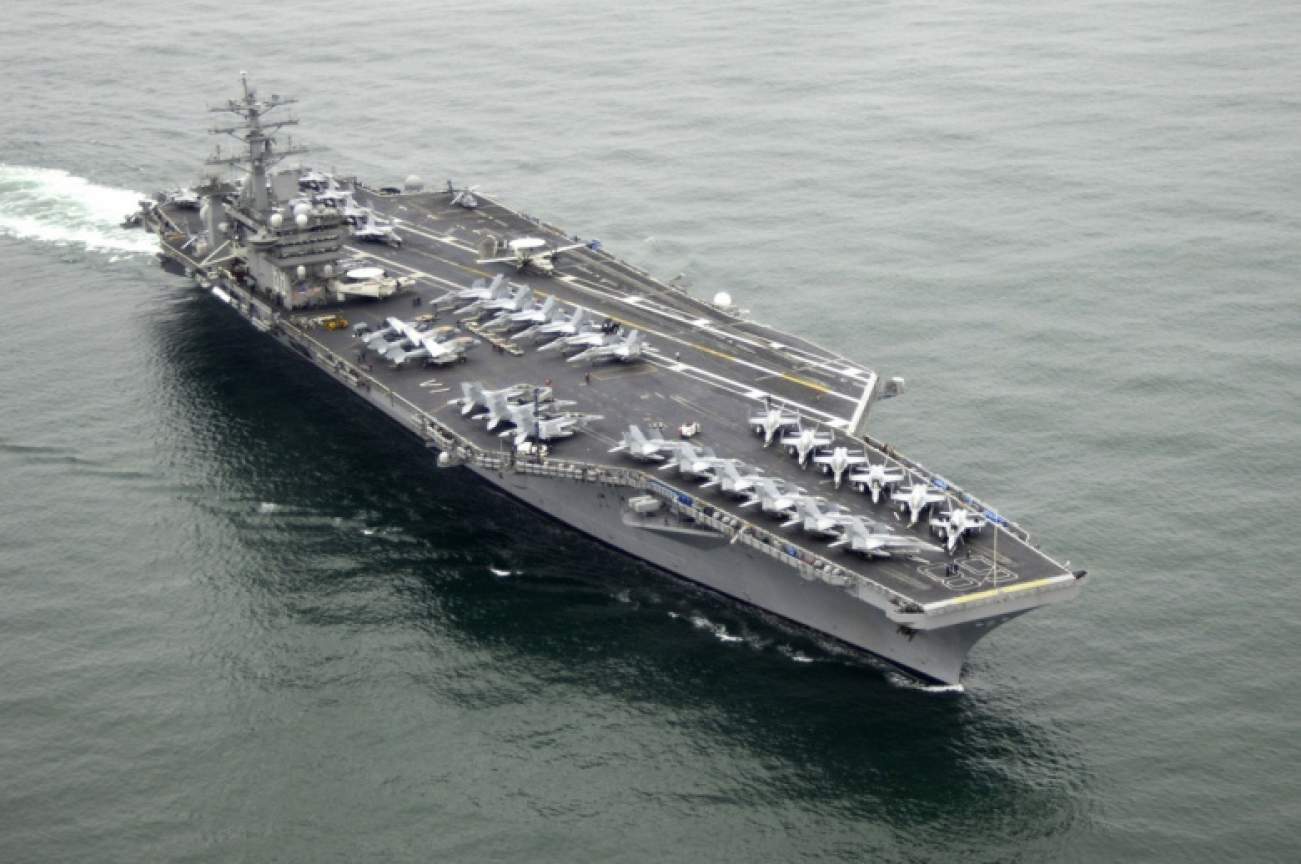How a Massive Naval Blockade Could Bring China To Its Knees In a War
In the context of a Sino-American war, the United States could try to take China’s greatest national strength—its export-oriented, booming economic-growth model—and transform it into a major military weakness. To do so, the United States would implement a naval blockade of China that attempted to choke off most of China’s maritime trade. Under the right conditions, the United States might be able to secure victory by debilitating China’s economy severely enough to bring it to the negotiating table.
Yet until recently, a blockade strategy was largely overlooked, perhaps because economic warfare strategies seem inherently misguided given the close commercial ties between China and the United States. But if a serious conflict between the two nations erupted, then their immediate security interests would quickly override their trade interdependence and wreak enormous economic damage on both sides, regardless of whether a blockade were employed.
Even if a blockade is never executed, its viability would still impact American and Chinese policies for deterrence reasons. The United States’ regional strategy is predicated on the belief that a favorable military balance deters attempts to change the status quo by force, thus reassuring allies and upholding strategic stability. The viability of a blockade influences this calculus, and can accordingly affect American and Chinese actions—both military and nonmilitary—that are based on perceptions of it. If a naval blockade is a feasible strategy, it strengthens the American system of deterrence and dilutes any potential attempts by China to coerce the United States or its allies. Moreover, if a blockade’s viability can be clearly enunciated, it would also enhance crisis stability and dampen the prospects of escalation due to misunderstandings—on either side—about the regional balance of power. In short, as Elbridge Colby put it: “the old saw remains true, that the best way to avoid war is to prepare for it.”
While a blockade is not a priori impossible or irrelevant in any situation, it is also not a ready tool in the American arsenal and would be feasible mainly within certain boundaries. Most importantly, many commentators miss the fact that a blockade is a context-dependent strategy, one that crucially depends on the regional environment.

Earlier this year, a Chinese frigate locked weapon-targeting radar on a Japanese destroyer near the Senkaku Islands. Both Japan and China lay territorial claims to these uninhabited islands, which are close to both Okinawa and Taiwan. This is one of many territorial disputes that China has in the South and East China Seas.
Needless to say, there was no escalation in this particular instance: the Japanese destroyer did not respond, and the only volleys fired were of a diplomatic nature. But what if things shake out differently next time? It is not hard to imagine such a scenario spinning out of control and leading to a shooting war. What would the U.S. do if this led to a larger regional war?
Under this and many other scenarios, the U.S. would be obligated to defend its allies. One way in which it might do this would be through a blockade of Chinese maritime traffic by U.S. forces, with the explicit support of nations that control key international straits, including Indonesia and Malaysia. Though it would be costly and risky, a blockade could prove decisive. T.X. Hammes and Sean Mirski contend that in the right circumstances, particularly a limited war of long duration, blockade could be a war winning strategy.
At the same time, however, a blockade would not be without its pitfalls. It would take a long time to enact. It would have to balance interdiction of oil imports against economic exports. And a blockading nation would also need to consider how to “hold the line” to prevent China from achieving its goal (in the above example, securing sea control of the Senkaku Island) while a blockade was taking effect.
Given its potential utility and also its possible downsides, decision makers and theater commanders must understand how a blockade of China would actually work and the precise conditions under which it holds promise.
What Should Be Blockaded?
When considering a blockade, the first question is: what commodity is to be targeted? One obvious option is to target everything. NWP 1-14, the Commander’s Handbook on the Law of Naval Operations, states that the belligerent right of blockade allows interdiction of all vessels and aircraft, regardless of cargo, crossing an exclusion zone. Blockades established to starve a civilian populace are illegal, but a reasonable case could be made that China’s agricultural resources and medical capabilities can provide for the civil population even during a blockade.
But just because an option is legal, it is not necessarily wise. Total blockades, such as the Union blockade of the Confederacy or the German U-Boat campaign against Great Britain, are difficult and expensive. It is more efficient to target specific commodities. For instance, during World War II, the United States used both the strategic air campaign in Europe and the submarine campaign in the Pacific to effectively target Germany’s and Japan’s oil infrastructures. Such a strategy would prove effective in a long term conflict with China.
Indeed, much as it was for Nazi Germany and Imperial Japan, oil is China’s Achilles’ heel. Chinese domestic oil production supplies only 40% of peacetime consumption and demand continues to increase, even during periods of zero or negative growth in exports (see 2001 and 2009). Another advantage of targeting oil is the ease of discrimination. An oil tanker is a unique vessel, easing the blockaders’ burden when identifying and prioritizing targets. Significant smuggling of oil in other types of ships is impractical. In addition, China would have a hard time importing enough oil over land due to difficult terrain, underdeveloped pipelines and competition for Russian oil.
However, China recognizes its reliance on foreign oil and has taken steps to reduce its vulnerability to supply disruptions. Specifically, China has established a robust strategic oil reserve. China’s 2011 strategic oil reserve was sufficient to supply 100% of domestic consumption (factoring in domestic production) for 25 days without rationing. Improvements to this reserve are planned to more than double its duration by 2020, even factoring in an increase in Chinese oil demand.
The effect of a war on China’s demand for oil must also be considered. China uses oil mostly for transportation, so given that a war would reduce Chinese exports (it would not, after all, continue trading with the United States and Japan), the demand for oil to transport goods would go down. Overland transport mitigates China’s reliance on maritime oil, even though it provides only a small share of China’s total need. A blockader also must be wary of resale of neutral oil that is allowed past the blockade, requiring a strong coalition to surround China. Rationing, while it would be unpopular with the Chinese people, would further reduce demand for oil.
China’s export income of $2 trillion would be hard hit simply by declaring such a blockade (in addition to the immediate loss of revenue from U.S. ports closing their doors to China). This immediate loss to China could provide the catalyst to end hostilities, and if China made a poor transition to a wartime economy, a disgruntled middle class could cost the Chinese Communist Party dearly, thus reducing the perceived value of a war.
Still, the Chinese economy has proven resilient in times of reduced trade by replacing export income with internal investment and stimulus. If China determined that the war objectives were worth the loss of exports, effectively managed nationalism could,in the short term buoy popular will during the immediate economic hardship. As enthusiasm for the war effort faded, governmental control over the economy could then be leveraged to spur domestic development for long term maintenance of the economy (investment in fixed capital contributes 75% more to China’s economy than exports and government stimulus could increase this more).
But because the shift to domestic development would still require oil, the operational emphasis of a blockade should be on stopping oil while interdicting targets of opportunity when practicable. Periodically interdicting a container ship gives credence to the export blockade and drives away customers, while the main effort still focuses on compromising China’s oil situation. After all, WWII submariners still sank troop ships; they just sank the tankers first.
How Should a Blockade Be Conducted?
An ideal blockade of China would use multiple layers, with each layer having a different purpose. These layers should include (1) a distant conventional blockade focused on chokepoints of sea lines of communications to China; (2) a close, unconventional maritime engagement zone, and (3) diplomatic engagement to embargo points of embarkation.
The most critical part of the blockade is the first: control of key chokepoints using conventional forces. The focal point of this blockade would be the Strait of Malacca and nearby archipelagic straits through Indonesia. These locations derive the protection of international law and the UN Convention of the Law of the Sea, which states that that belligerents cannot operate in neutral waters. Consequently, to make the blockade legal, the countries bordering the Strait of Malacca must explicitly support a blockade, becoming belligerents themselves. While failing to gain Malaysia’s support would be a surmountable challenge – it might simply move the blockade 12 miles outside the straits into international waters – Indonesia’s support will make or break a blockade. Its archipelagic sea lanes (at least four basic routes) provide several corridors for blockade runners exploiting innocent passage. Without Indonesian support, only a United Nations Security Council Resolution allows closure of these sea lanes, and China’s Security Council veto would never allow that.
Even setting legalities aside, a blockade of the Strait of Malacca would be a complicated undertaking. Given the vast quantity of traffic that transits these chokepoints—much of it bound for allied or neutral countries—traditional methods of visit and search are challenging. Approximately 165 ships of all types transit the Strait of Malacca each day, of which 52 are oil tankers. A blockader would need to investigate all appropriate ships, evaluate whether they were blockade runners, and seize those that were. As many as thirteen warships would be required to enforce an oil blockade using traditional methods of visit and search . This number does not allow for force protection, replacements for material failures or prize crews. Additional ships would have to guard other passages such as the Lombok/Makassar straits. Increased insurance rates and risk-averse shippers would reduce that number of tankers destined for China; however, China’s large national fleet and other Chinese owned merchants would still sail, and China’s significant cash reserves could supplant traditional insurers. As such, the operational commander would still need to dedicate a squadron of significant size to blockade, revealing a major opportunity cost.
It is possible to reduce this footprint if some measures are taken during peacetime (there is no time like the present). Specific examples include development of procedures, relationships and technologies to establish a Navicert system for shipping and stand up land-based Visit, Board, Search and Seizure (VBSS) teams from the Coast Guard and land forces. A Navicert process is a prescreening of traffic at the port of embarkation previously used by the British during their blockades of Germany, which could make blockade inspections more efficient. Combining a Navicert process with an electronic system such as the Automatic Identification System (an automated data system installed on all ships 300 tons or larger that reports a wealth of information) increases the potential for success. A commander can use land based VBSS teams augmented with drones, helicopters and small boats to supplement warships in critical chokepoints, allowing precious destroyers and cruisers to assist in other efforts. These capabilities would be difficult to develop “on the fly” in wartime, so capabilities and relationships should be fostered now to improve their effectiveness at the onset of hostilities.

The teeth of the endeavor would be a close blockade using assets that can survive and strike in an anti-access, area denial (A2/AD) environment, which means that something like AirSea Battle might still be needed for a blockade to be effective and feasible). The force commander could focus on Hong Kong, Shanghai and other major shipping hubs to begin with, while preparing to expand as China adapted. This portion of the blockade would consist of submarines, mine warfare, and long range aircraft that would attack blockade runners that slipped through or around the chokepoints and entered a Maritime Exclusion Zone (MEZ) defined by the coalition. The MEZ would not need to be 100% impregnable, but a sufficient volume of traffic would need to be sunk to create a deterrent effect on potential blockade runners. Traditional concepts of establishment, notification, effectiveness, impartiality and limitationswould still apply to provide a legal, internationally acceptable basis for this second tier of the blockade.
The third level of blockade would be diplomatic efforts to stop oil transport at the supply side, focusing on convincing nations to support an oil embargo of China. China gets most of its oil from Iraq, Saudi Arabia, Iran, Russia, Oman, Angola, Sudan, and Kuwait. While many of China’s oil suppliers are antagonistic toward the United States, American allies such as Saudi Arabia who provide significant oil to China could be convinced to support a blockade. As oil is a commodity, the United States would need to seek diplomatic support to find alternative customers for its allies (even to the extent of adding this Saudi oil to American strategic reserves). Once some Chinese oil suppliers take their product off the market, nations not supporting an oil embargo of China would then be forced to create new facilities and infrastructure if they wished to supply a risky, temporary demand.
Overland Routes and Chinese Retaliation
While maritime blockade offers a strong possibility of success, Russia could decide to support China with oil over land routes. However, Russia is limited in its ability to support China by their supply and other markets. 78% of Russia’s exported oil goes to stable, long term European markets. Robbing these markets or overinvesting in production to support a massive surge in short term Chinese demand is not in the best interest of Russia’s oil oligarchs, even if it meant poking the United States in the eye. Expanding infrastructure, specifically pipelines and railways, to support Chinese oil needs is also an expensive and time-consuming effort. As such, Russia would have an uphill climb to validate such investment as part of their national interest. Other overland routes need to be monitored for expansion, though unforgiving terrain, unfriendly nations and reliance on maritime transport reduce the efficacy of these alternate routes.
China would have difficulty challenging a blockade through a major naval battle or convoy operations, due to its limited capability to project sea control away from its home waters. However, an operational commander must also consider China’s response, particularly the potential for asymmetric action. Just like other naval operations, a blockade would rely on satellite coverage for communications and reconnaissance as well as digital data exchange to track blockade runners and operate a Navicert process. This is all vulnerable to Chinese attacks with anti-satellite weapons and in cyberspace. These actions may not be fatal to a blockade, but they would significantly increase the forces required and reduce capability to stop blockade runners.
While conducting this blockade, coalition forces must also prevent China from seizing disputed territory from allies such as the Senkaku Islands or Taiwan. As stated earlier, continuing this fight would require operations in an A2/AD environment. The United States also has to be prepared for a scenario where China achieves its objectives very quickly – say, seizing the Senkakus – and ceases combat operations. Would popular opinion and international consensus support excluding China after a quick and possibly bloodless seizure of some small islands? At this point, a continued blockade would be seen as purely punitive, and international and domestic economic interests would pressure the United States to back down.
Conclusion
There is no way to fight an easy war against China. China’s geographic advantages, niche military capabilities, economic interdependence and nationalistic populace will make any war costly, regardless of the strategy. A blockade uniquely negates many of China’s strengths and capitalizes on its weaknesses, but China still retains many options to continue to fight and achieve its objectives. And a blockade would require significant military resources, time, and commitments from allies.
In addition, the United States cannot simply step outside China’s A2/AD’s range and blockade from a safe distance. If China chose to continue the war despite initial economic repercussions, the United States would be forced to enter the A2/AD environment, both to establish an effective close blockade and to challenge China at decisive points to keep allies in the fight. AirSea Battle may provide a solution to this, or another construct may need to be developed, but the United States still needs to understand how to operate in almost any environment should the military be called to.
Regardless, the problem of blockade is less of military feasibility and more of political will and economic sacrifice. The interests of the United States may be best served by economic and diplomatic engagement with China; however, uncertain times and irreconcilable interests could still provoke a war that the United States needs a strategy for. As such, the United States should not take any strategy off the table, particularly blockade.
A blockade would not be employed lightly by the United States, given its significant potential costs. Accordingly, Washington would likely only consider employing a blockade in a protracted conflict over vital interests; anything less would simply fail a basic cost-benefit analysis.
More importantly, though, a blockade strategy would depend on the cooperation of several third parties in the region. After all, China’s trade is borne on the seas largely as a result of economic considerations rather than physical limitations; if China were blockaded, it would turn to the countries on its borders for help.
While many of its neighbors would be unable to make a strategic difference because of their rugged geography or their small size, three could prove vital: India, Japan, and Russia. The latter two would be important in helping the United States by cutting off China’s trade routes in its south and east, respectively, through implementing national embargoes on China and pressuring their smaller neighbors to do the same. Without their cooperation, the United States’ task would become much more difficult.
The last of the three neighbors—Russia—would be the lynchpin of a successful blockade, and could tip the balance of a blockade in favor of either China or the United States. On the one hand, Russia is remarkably well-positioned to alleviate the blockade’s effects on China. Russian trade would be immune to American interdiction, since Russia’s nuclear arsenal and significant conventional assets preclude any serious American attempts at military coercion. But on the other hand, China’s northern neighbor could also sound the death knell for China’s ability to resist a blockade. On the political level, Moscow continues to exert sway over the decisions made in the capitals of China’s Central Asian neighbors and could convince them to refuse Chinese entreaties to act as transit states. It could also guarantee that China’s two neighboring oil producers would no longer supply it with petroleum.
Accordingly, for the United States to implement a strategically effective blockade of China, it would strive to build a “minimum coalition” with India, Japan, and Russia. If all three states made common cause with the American blockade, then China would be placed in both an economic and a political stranglehold. If not, however, a blockade strategy would regionalize a Sino-American war in a way that would be fundamentally unfavorable to American interests.
Such a minimum coalition could only arise in one way: on the heels of an assertive Chinese push for regional hegemony that precipitates local support for a drastic American response. Short of anything but an aggressive China, collective embargo action will be deterred by the potential consequences of a blockade, not least of which is the possibility of a larger regional conflict with China. The four states are unlikely to coalesce together around an implicit containment policy until each feels that its national interests may be threatened by China in the future.
While such a possibility may appear distant at present, the United States, Japan, India and Russia all fear that Beijing might someday conclude that it must use force in order to protect its interests and to resolve its security dilemma on favorable terms. All four powers have increasingly hedged their bets against this possibility. If China’s power and influence in Asia continues to increase, then the bonds between all four states will strengthen, not out of any conviction about China’s belligerent intentions, but rather because of a profound uncertainty as to their future disposition.
The Central Operational Challenge
Even assuming that the United States can rally the necessary coalition together, it would squarely face an operational challenge that bedevils all modern-day blockade strategies.
Operationally, blockades are characterized by their distance from the coast of the blockaded state, and they come in two forms: close and distant. A close blockade is typically enforced by stationing a cordon of warships off an enemy’s shores to search all incoming or outgoing merchant ships and to impound those carrying contraband. Over the last century and a half, though, close blockades have become increasingly dangerous as belligerents developed the technology to project power from their coasts. In response, blockading powers have turned to distant blockades. A distant blockade avoids the military hazards of being located near the enemy’s shores by stationing itself at a distance, albeit still astride the enemy’s sea lanes, and it then chokes off the enemy’s trade in a similar manner to the close blockade.
Neither a close nor a distant blockade of China alone would be successful thanks to the constraints imposed by military requirements and the nature of maritime commerce. On the one hand, a conventional close blockade would be severely complicated by the United States’ desire to minimize the military risk to American warships. As American forces came closer to China, they would increasingly place themselves within range of China’s A2/AD complex, possibly limiting their operational freedom and resulting in heavy losses. American forces could avoid the perils of China’s A2/AD system by implementing a close blockade enforced by submarines, long-range air power, and mines; but by so doing, the blockade would also lose much of its ability to differentiate between neutral and enemy commerce.
On the other hand, the logic behind conventional distant blockades has similarly been undermined by the exigencies of modern commerce. Today’s cargoes of raw materials and merchandise can be sold and re-sold many times in the course of a voyage, so the ultimate ownership and destination of a ship’s cargo is often unknowable until the moment it docks. Although the United States might be able to set up a conventional distant blockade that quarantined all Chinese-owned or -flagged vessels, China could still simply buy neutral vessels’ cargoes after they had passed through the blockade, defeating its entire purpose.







